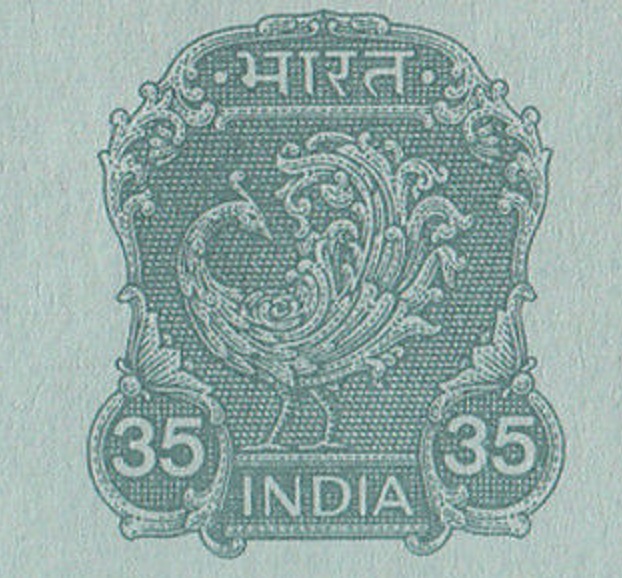
Growing up in India in the ’70s, I don’t remember being one of her favorite [pullquote align=”right”]She was old fashioned and it suited me well.[/pullquote]grandchildren. There were after all twenty others competing for her affection, but being a boy, I got my inequitable share of her attention and material blessings. My portion of fruit was fresher, meals more buttery and came in larger portions than any of the granddaughter’s. She was old fashioned and it suited me well. All she expected in return, along with quick marriages and multiple babies, her expectations made clear even when I was barely 10 years old, were handwritten responses to her letters addressing her as the “venerated god-mother.” A title that was as obsolete as her worldview. But I obliged nevertheless, partly because butter was in short supply.
Refusing to move in with any of her children after my grandfather died, she kept in touch via letters. The In-Land letter, possibly the most well-known product of the Government of India, was her weapon of choice. She used the light blue sheet of paper to strafe us with information week after week. The prepaid, pre-gummed sheet of paper with folding flaps on its edges was the ubiquitous tool of communication among the rank and file. It was inexpensive (35 Paisa) and occupied the sweet spot between a postcard (10 Paisa) which provided no privacy and the pricier prepaid envelope (50 Paisa). She often hid stacks of In-Land Letters under her mattress, hedging her bets against price hikes and postal shortages.
With unfailing regularity, she shot off letters to all seven of her children, composing them simultaneously [pullquote]Lax editorial skills coupled with her inability to curate this information made the letter resemble a cryptic war communique.[/pullquote]over many weeks, coming back to her works over time, gestating them but eventually confusing herself and the reader with logical and chronological inconsistencies. She compiled all the information that came her way: neighborhood gossip, births and deaths, recent scientific findings, movie recommendations and political commentary. Unfortunately, lax editorial skills coupled with her inability to curate this information made the letter resemble a cryptic war communique. An Enigma machine would have been barely competent in decoding it.
She compounded the confusion by writing in the tiniest font she could manage, the information seamlessly overflowing from the main body of the letter to the flaps. The sender’s address box was also not off-limits. Last minute information was added in the “From” address box after the letter had been folded and glued and additional instructions were given asking my mother to either ignore or change the information that was present in the main body of the letter, which she proclaimed was neither interesting nor relevant by the time she finished writing it.
There were no instructions, numberings or arrows to guide you as you roamed the florid landscape. Fortunately, two things were constant in her letters and helped establish the most basic reading sequence — one was the Sanskrit character Om which marked the beginning, and the other, a small invocation to her favorite god marking the end. Sometimes, both clues ended up in the same line converting the deceptively simple sheet of paper into a Mobius strip of information.
She routinely violated the “No Enclosures Allowed” rule set forth in bold letters. Her “blessings” were sent by sprinkling the letters with her collection of vermilion, ash and turmeric powders from the various temples she visited before she folded and glued them. When we opened them, we were covered with the dyes, the resulting stains that were difficult to wash off, made the blessings permanent.
Over the years as she got older, the frequency of letters slowed down. She was finding it difficult to write in her characteristic style and writing in larger fonts was considered an affront to her frugality and pride. Towards the end, she barely moved from her bed and a newly acquired landline phone was her only communication tool. [pullquote align=”right”]We found a stack of fifty unused In-Land letters, the blue fading away, the papers soft and creased as if they had aged along with her.[/pullquote]The conversations were not as charming as her letters and I couldn’t bring myself to address her as the “venerated god-mother” over the phone.
When she passed away in 1995, I was working in Bombay and had neither the wealth nor the political connections to get a phone line and ironically, was informed via a telegram with the most minimum words: “Ajji passed away. Start immtly.” When we finally cleaned her room and put her things away, we found a stack of fifty unused In-Land letters, the blue fading away, the papers soft and creased as if they had aged along with her, still marked with the 1980s price sticker of 35 Paisa.
* * *
An engineer by training but a writer at heart, Aman runs his own company and lives in Brookline, Massachusetts. This essay is a piece of memoir he wrote as part of an ongoing collection for his daughter. India as she knows it through annual visits is far different from the one he grew up in, and he hopes that a collection of these vignettes serves as a field guide for her to understand her father.












